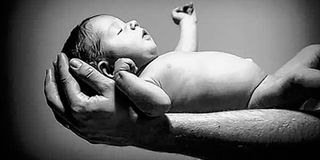Kisumu: A place where men are allowed inside labour room

A father holding a new born baby in his hands. Many women today feel the importance of the presence of her child’s father during delivery. PHOTO | FILE
What you need to know:
- It is also the most litigated worldwide, and Kenya has not been spared either. A quick look at the professional negligence complaints filed at the Kenya Medical Practitioners and Dentists’ Board reveals that at least 70 per cent are obstetric in nature.
The mention of labour and childbirth evokes images of women in pain followed by the cry of a newborn. Obstetrics, the medicine of pregnancy and childbirth, is one of the most controversial aspects of the practice of medicine.
It is also the most litigated worldwide, and Kenya has not been spared either. A quick look at the professional negligence complaints filed at the Kenya Medical Practitioners and Dentists’ Board reveals that at least 70 per cent are obstetric in nature.
Traditionally, the role of attending to birthing was a women’s affair and generally men kept their distance, even from the newborn. In the West, male relatives only came together at the baby’s christening to officially meet the new family member. In Kenya, cultures vary, but childbirth was — and largely continues to be — distinctly a female affair.
In countries such as the United Kingdom, approximately 95 per cent of women are accompanied by their partners in labour. Nevertheless, the concept of fathers as birthing partners is still fairly new in Kenya. Despite being allowed in private hospitals for many years, it has taken very long to take root.
Family dynamic
For the woman in labour, the companion that she comes with to the hospital may be the only truly familiar person in that space. While among the Asian, Somali and Swahili communities the woman is accompanied by a several female family members who will stay until the baby is safely delivered, this support is greatly waning among the rest of the communities.
Urbanisation, with emphasis on the nuclear family, single motherhood and family separation due to career choices, has led to women turning up in our labour rooms unaccompanied. The husband may have travelled for work and the woman may be taken to the hospital by the driver, with no family member present.
On the flipside, women from lower socio-economic backgrounds may be worse off. Domestic workers who may successfully hide the pregnancy from their employer until labour sets in will show up at the hospital even without basic necessities for themselves and the baby!
Single mothers going into labour in the dead of night may have no one to call upon and will arrive alone in a cab clutching their baby bags, ready to get over and done with birthing and go back to the privacy of their houses. In the villages, with husbands away in the city toiling to sustain their families, the young wives will be escorted to hospital and everyone leaves, waiting to come and take the new mom and baby home after discharge the next day.
In this wanting picture, the County of Kisumu, with the support of partners, seeks to turn things around. The County has spruced up the maternity unit, providing patient privacy, which allows spouses into the labour ward to be with their wives or partners during this very crucial time in a mother’s life.
The benefits expected out of this intervention are immense. Whereas in the first world the primary concern is lowering Caesarean Section rate, in Kenya the participation of men in maternity is a sure way of recruiting their support in reducing maternal mortality and morbidity.
The major challenge to effective emergency response during pregnancy, childbirth and post-delivery period is what has been aptly categorised by the World Health Organisation as The Three Delays resulting in maternal death:
Delay in seeking care: This can be occasioned by failure to recognise the emergency and failure to make the decision to seek care in good time.
Getting it right
Delay in identifying and accessing a suitable health facility: This results from financial constraint; lack of roads, ambulances or even just a taxi at the critical time; lack of knowledge of the level of care a facility can provide hence wasting time in uncoordinated referrals; and lack of social support structures to escort the mother to the hospital.
Delay in accessing quality care: This falls squarely on the hospital and results from a wide array of system failures internally, such as lack of adequately experienced staff, equipment, and drugs, and overcrowding.
It is therefore fairly obvious why men, who continue to be major decision makers in the family, should be involved intimately. They learn to appreciate emergencies and timely response. Even more importantly, they provide much needed emotional, physical and psychological support to the mother in need.
Kisumu County most certainly got this right. It demonstrated that being a public hospital should not be a barrier in providing the highest attainable standards of care. It has embraced the core tenets of primary health care by fully embracing community involvement and changing mindsets.




